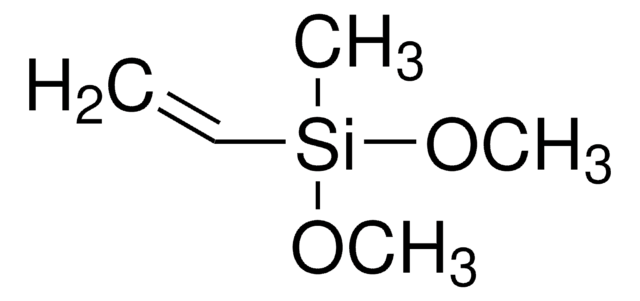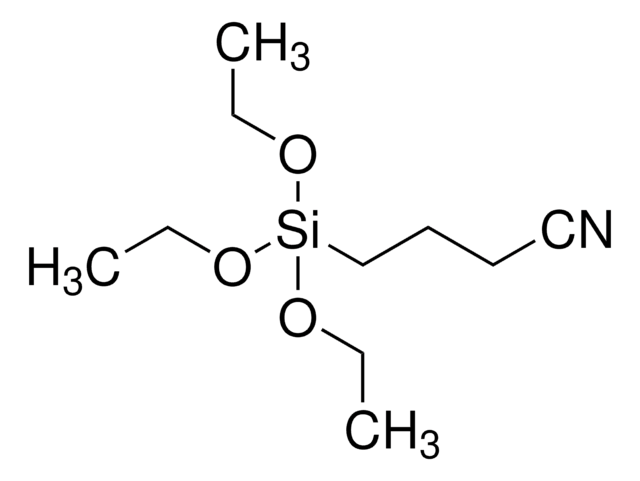全部照片(1)
About This Item
經驗公式(希爾表示法):
C9H20O4Si
CAS號碼:
分子量::
220.34
EC號碼:
MDL號碼:
分類程式碼代碼:
12352103
PubChem物質ID:
NACRES:
NA.23
推薦產品
化驗
97%
形狀
liquid
折射率
n20/D 1.432 (lit.)
bp
100 °C/4 mmHg (lit.)
密度
1.02 g/mL at 25 °C (lit.)
SMILES 字串
CO[Si](C)(CCCOCC1CO1)OC
InChI
1S/C9H20O4Si/c1-10-14(3,11-2)6-4-5-12-7-9-8-13-9/h9H,4-8H2,1-3H3
InChI 密鑰
WHGNXNCOTZPEEK-UHFFFAOYSA-N
一般說明
3-Glycidoxypropyldimethoxymethylsilane (GDMMS) is an epoxy-silane that is used to form a silane based coupling agent for functionalization of a variety of substrates. The epoxy groups allow good adhesion of surface atoms and form a stable polymeric structure.
應用
3-Glycidoxypropyldimethoxymethylsilane (GDMMS) precursor was used to develop zwitterionic push – pull chromophore and carbazole-derivatives-doped hybrid organic–inorganic homogeneous films.{71}
GDMMS can surface modify indium tin oxide (ITO) glass substrate for the immobilization of surface atoms which can be further used for the electrochemical detection and labeling. It can also be used as a hardener in the formation of multi-component silicone based rubber.
The usual cure time is 16-20 hours at room temperature or 1 hour at 100C.
儲存類別代碼
10 - Combustible liquids
水污染物質分類(WGK)
WGK 3
閃點(°F)
221.0 °F - closed cup
閃點(°C)
105 °C - closed cup
個人防護裝備
Eyeshields, Gloves, multi-purpose combination respirator cartridge (US)
客戶也查看了
Headgroup effect on silane structures at buried polymer/silane and polymer/polymer interfaces and their relations to adhesion.
Zhang C, et al.
Langmuir, 28(14), 6052-6059 (2012)
Surface functionalization using catalyst-free azide- alkyne cycloaddition.
Kuzmin A, et al.
Bioconjugate Chemistry, 21(11), 2076-2085 (2010)
Label-free ITO-based immunosensor for the detection of very low concentrations of pathogenic bacteria.
dos Santos MB, et al.
Bioelectrochemistry, 101(11), 146-152 (2015)
Francesca Volpetti et al.
ACS synthetic biology, 6(11), 1979-1987 (2017-08-05)
Synthetically engineered cells are powerful and potentially useful biosensors, but it remains problematic to deploy such systems due to practical difficulties and biosafety concerns. To overcome these hurdles, we developed a microfluidic device that serves as an interface between an
Electro-optics poled sol?gel materials doped with heterocycle push?pull chromophores.
Della Giustina G, et al.
Materials Science & Engineering. C, Materials For Biological Applications, 26(5), 979-982 (2006)
我們的科學家團隊在所有研究領域都有豐富的經驗,包括生命科學、材料科學、化學合成、色譜、分析等.
聯絡技術服務




![二乙氧基甲基[(3-环氧乙烷基甲氧)丙基]硅烷 97%](/deepweb/assets/sigmaaldrich/product/structures/319/579/0dee85a5-ba26-4338-be17-aa88b1de6ffd/640/0dee85a5-ba26-4338-be17-aa88b1de6ffd.png)







